Introduction
In an age where digital innovation is no longer optional but essential, businesses are confronted with the imperative to transform their operations and customer interactions through technology. Digital transformation transcends mere technological adoption; it requires a holistic reimagining of processes, culture, and customer engagement strategies.
For organizations in the e-commerce sector, this transformation can lead to remarkable enhancements in operational efficiency and customer satisfaction, driving growth and profitability. However, the journey is not without its challenges, as many companies grapple with resistance to change and the complexities of integrating new systems.
As the landscape continues to evolve, understanding the nuances of digital transformation becomes crucial for businesses aiming to thrive in a competitive marketplace. This article delves into the key drivers, benefits, and best practices that underpin successful digital transformation initiatives, equipping organizations with the insights needed to navigate this critical evolution.
Understanding Digital Transformation: A Comprehensive Overview
Technological advancement is fundamentally redefining how businesses function and engage with clients by integrating technology across all operations. This evolution entails not merely the adoption of new technologies but a comprehensive rethinking of processes, organizational culture, and customer experiences through digital transformation services and solutions. In the e-commerce sector, digital transformation services and solutions significantly boost operational efficiency, enhance customer engagement, and fuel considerable growth, particularly through tailored approaches that have a proven track record in improving critical KPIs such as:
- Retention rates
- Average Order Value (AOV)
- Lifetime Value (LTV)
These solutions not only enhance these KPIs but also generate incremental revenue and build community value by aligning product offerings with customer needs. Nevertheless, entities encounter obstacles, with 14% indicating a resistant corporate culture as a major hindrance to effective change. As organizations increasingly recognize the importance of this shift, 44% express concerns regarding the need to establish dedicated teams for driving transformation initiatives.
Furthermore, companies that utilize digital transformation services and solutions are better equipped to adapt to market fluctuations, leverage data analytics for informed decision-making, and offer personalized experiences to their customers. For instance, businesses that have implemented customized e-commerce solutions have seen significant improvements in customer loyalty and engagement. The Mulesoft Connectivity Benchmark Report highlights a projected 360% growth in API traffic by 2025, underscoring the necessity of robust infrastructure for integrated services in the online ecosystem.
According to PwC, by 2030, a staggering 80% of organizations will have established frameworks for responsible AI, emphasizing the need for advanced technological solutions. This strategic alignment not only boosts competitiveness but also positions enterprises to succeed in a constantly changing marketplace, where customer demand and the need to stay competitive propel the urgency for technological advancement.
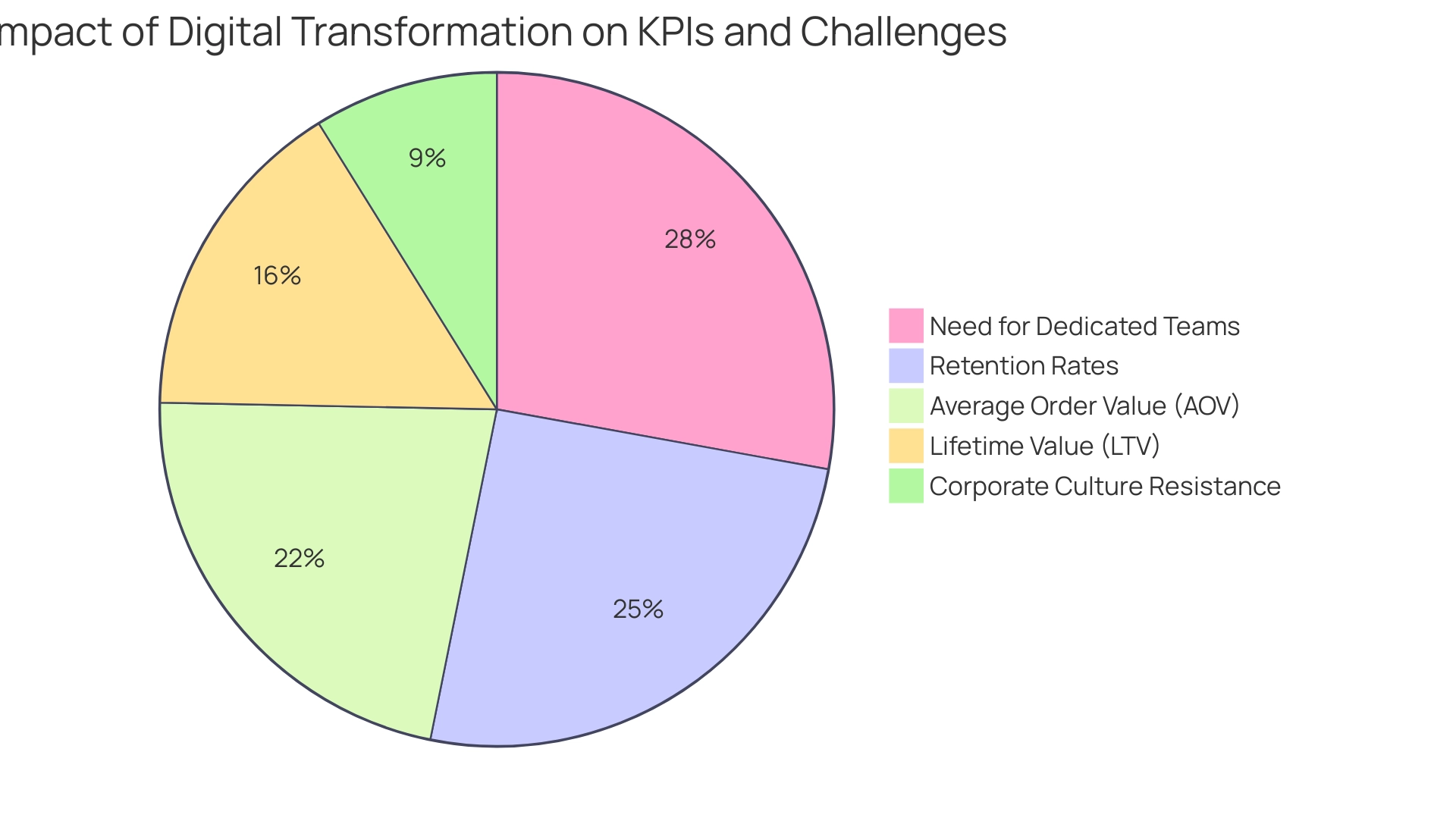
Key Drivers and Benefits of Digital Transformation
A variety of key drivers are currently steering businesses toward digital transformation services and solutions, primarily focusing on enhancing customer experiences, boosting operational efficiency, and gaining a competitive edge. Our customized e-commerce solutions, crafted for sectors like content publishing, charities, and conventional e-commerce entities, have a proven history of considerably enhancing critical KPIs, allowing entities to improve retention rates, boost Average Order Value (AOV), and increase Lifetime Value (LTV). These solutions not only build community value but also generate incremental revenue by helping your users win.
However, organizations also face significant challenges during this journey, including:
- Employee resistance
- Legacy system integration issues
- Inadequate data governance
- Cybersecurity concerns
As they navigate this online landscape, businesses can reap substantial benefits from digital transformation services and solutions, including:
- Increased agility
- Improved decision-making through advanced data analytics
- Heightened revenue through more effective marketing strategies
For example, the worldwide healthcare chatbots market illustrates this trend, anticipated to rise to $314.3 million from $122 million in 2018, showing a clear demand for technological solutions.
The healthcare sector, especially, has swiftly embraced technology-first strategies after the pandemic, with telehealth usage rising from 11% to 76%, demonstrating the concrete effect of technological change. Firms such as Amazon have established a standard in utilizing technological advancements to improve their operations and enhance customer satisfaction, reinforcing their market leadership. Notably, a staggering 17% of IT projects fail so dramatically that they jeopardize a company’s survival, underscoring the risks of ignoring digital transformation services and solutions.
As Veeam points out, 22% of IT leaders identify economic uncertainty as a major hurdle in this journey, yet failing to adapt could leave organizations trailing behind competitors who are already capitalizing on these advancements. With over 20 years of unparalleled experience, we are equipped to help your organization build community value and generate incremental revenue through tailored solutions. As we near 2024, the necessity for enterprises to adopt technological change has never been more evident, with the possibility for improved customer experiences and operational efficiencies propelling their success.
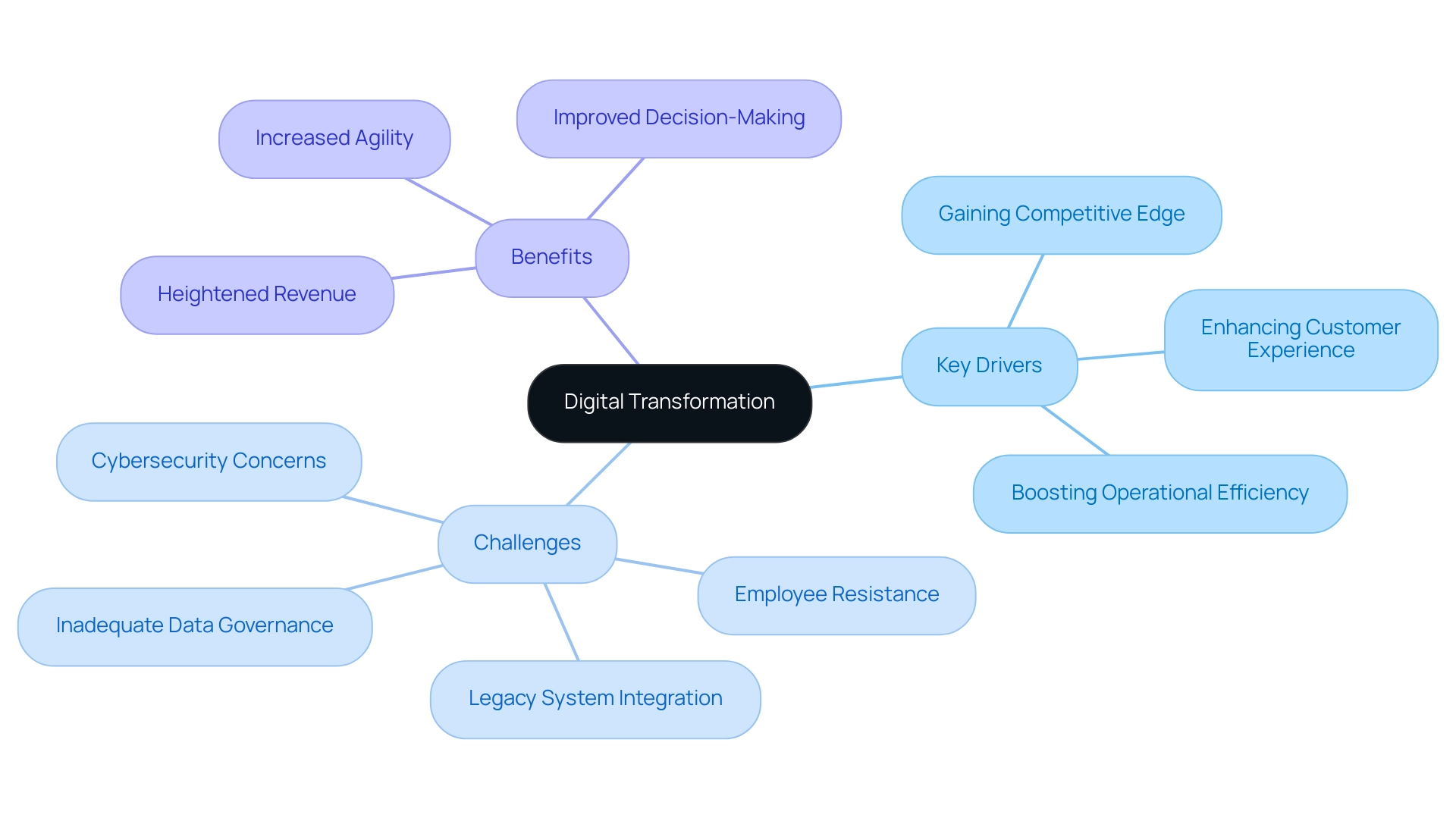
Aligning Digital Transformation with Business Objectives
Successful technological advancement relies on the strategic alignment between technological initiatives and overarching business objectives. Engaging leadership throughout this transformation process is essential, as effective leaders can champion change and facilitate smoother transitions. A thorough assessment of current capabilities against desired outcomes is vital.
For example, if a company seeks to improve customer engagement, its online strategies should concentrate on optimizing user experiences and utilizing customer data for personalized marketing efforts. With over 20 years of experience, we have developed tailored e-commerce solutions that significantly improve critical KPIs, including:
- Retention rates
- Average Order Value (AOV)
- Lifetime Value (LTV)
Ultimately fostering community value. Our solutions also focus on building incremental revenue for organizations by helping users achieve their goals.
Significantly, 17% of IT projects fail so drastically that they can jeopardize a company's existence, emphasizing the dangers linked to ineffective technological change initiatives. This alignment is not just a best practice; it is essential for maximizing investments in electronic advancement, particularly as firms that are more technologically advanced indicate being 23% more profitable than their less advanced peers. Furthermore, organizations must navigate common challenges, such as:
- Resistance to change
- Legacy system integration issues
- Inadequate data governance
As noted, 'Organizations often face challenges during their technological change journey, such as resistance to change from employees, legacy system integration issues, and inadequate data governance.' By maintaining clear alignment and measuring success through well-defined KPIs, organizations can ensure that their online change efforts contribute meaningfully to their strategic objectives. An organized method to technological change, as detailed in the case study titled 'Step-by-Step Approach to Technological Change,' involves:
- Identifying problem areas
- Defining goals
- Starting with smaller projects
- Engaging employees
Facilitating smoother adoption and better alignment with business objectives.
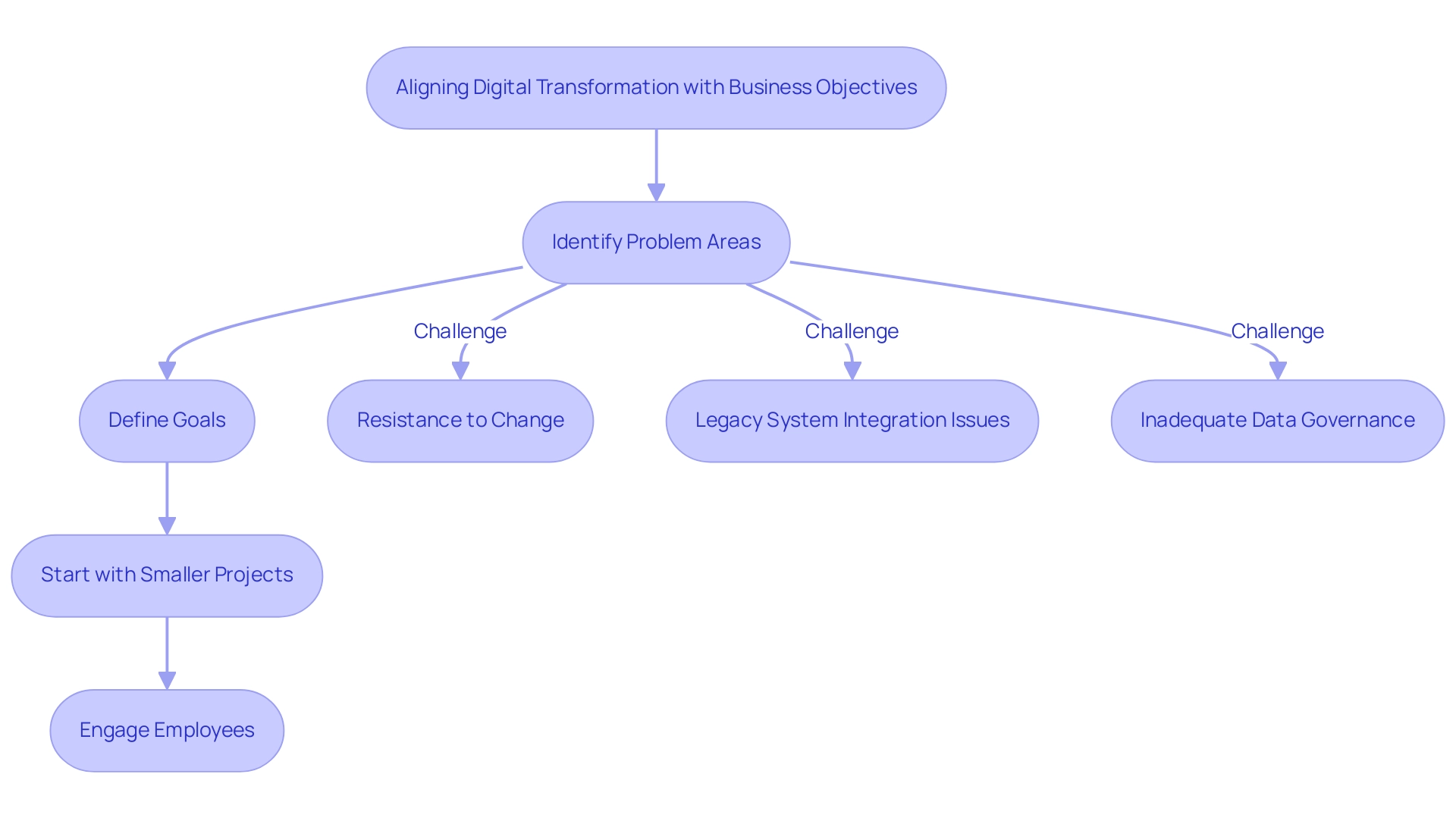
Best Practices for Selecting Digital Transformation Services and Solutions
When choosing digital transformation services and solutions, organizations can significantly enhance their success rates by adhering to the following best practices:
-
Conduct a Needs Assessment: Start by identifying the specific challenges and objectives that the change initiative aims to address. This foundational step ensures alignment between organizational goals and technological solutions.
-
Evaluate Vendor Expertise: Opt for providers that possess a robust track record in your industry, supported by relevant case studies. Organizations that have successfully transformed often benefit from vendors who understand their unique challenges and opportunities.
Significantly, companies that establish cross-functional or enterprise-wide hiring objectives based on particular skill requirements report a 27% success rate in their changes.
-
Prioritize Scalability: Select solutions that not only meet current needs but also have the potential to scale as your business evolves. This foresight is critical in an environment where COVID-19 has accelerated digital development initiatives by an average of six years.
-
Assess Integration Capabilities: It's essential that new services can seamlessly integrate with existing systems to avoid disruptions. Successful transformations typically involve a broader range of technologies; therefore, compatibility is crucial for effective execution. The case study titled "Technology Adoption in Transformations" highlights that entities utilizing a wide array of technologies, such as AI and IoT, tend to report higher success rates.
-
Request Demonstrations and Trials: Before making any commitments, seek hands-on experience with potential solutions. This practice enables entities to assess usability and fit within their operational landscape.
By adhering to these optimal methods, companies can enhance their prospects for successful technological change, particularly considering obstacles like economic instability, which 22% of IT leaders recognize as a major hurdle, based on recent surveys.
Adopting a strategic approach to choosing digital transformation services and solutions not only ensures alignment with immediate business objectives but also positions entities for future growth.
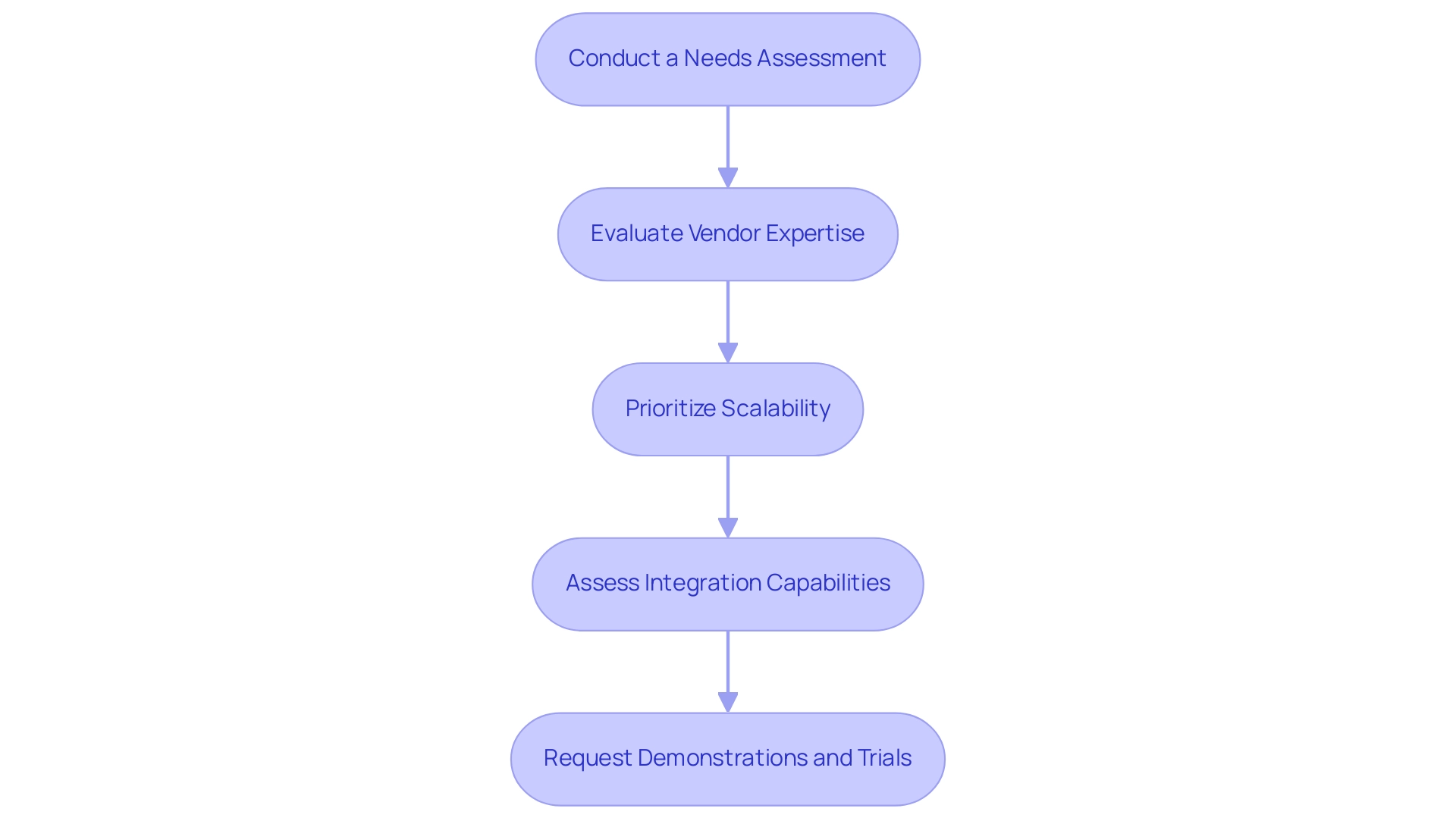
Navigating Challenges in Digital Transformation
Digital change is fraught with challenges that can significantly affect a company's success. A staggering 17% of IT projects fail so dramatically that they threaten the very survival of a company, as highlighted by McKinsey & Company. Common obstacles in this journey include resistance to change, a shortage of skilled personnel, and integration issues with legacy systems.
In fact, 53% of organizations indicate that locating the appropriate technology solutions is a significant issue when managing workplace change, according to Infosys. This concern is compounded by the fact that worldwide spending on digital transformation services and solutions is projected to hit $2.3 trillion by 2023, underscoring the urgency of addressing these challenges.
To effectively tackle these challenges, businesses should adopt the following strategies:
- Foster a Culture of Change: Cultivating an environment that encourages open communication and buy-in from all levels of the entity is crucial. This cultural shift can alleviate fears and motivate employees to embrace new technologies.
- Invest in Training and Development: With an expected increase in demand for IT skills due to AI advancements in 2023, equipping your team with the necessary skills will empower them to navigate the evolving technological landscape effectively.
- Start Small and Scale Gradually: Implementing pilot projects allows entities to test innovative solutions and learn from initial experiences before a wider rollout, minimizing disruption and resistance.
- Seek External Expertise: Engaging consultants or service providers can offer valuable guidance and insights, assisting entities in navigating their technological evolution journey more effectively.
Notably, around 75% of companies have initiated their technological evolution journey, with 55% launching or accelerating initiatives. By proactively addressing these challenges, organizations can significantly enhance their chances of success in digital transformation services and solutions, ensuring sustained progress and growth.
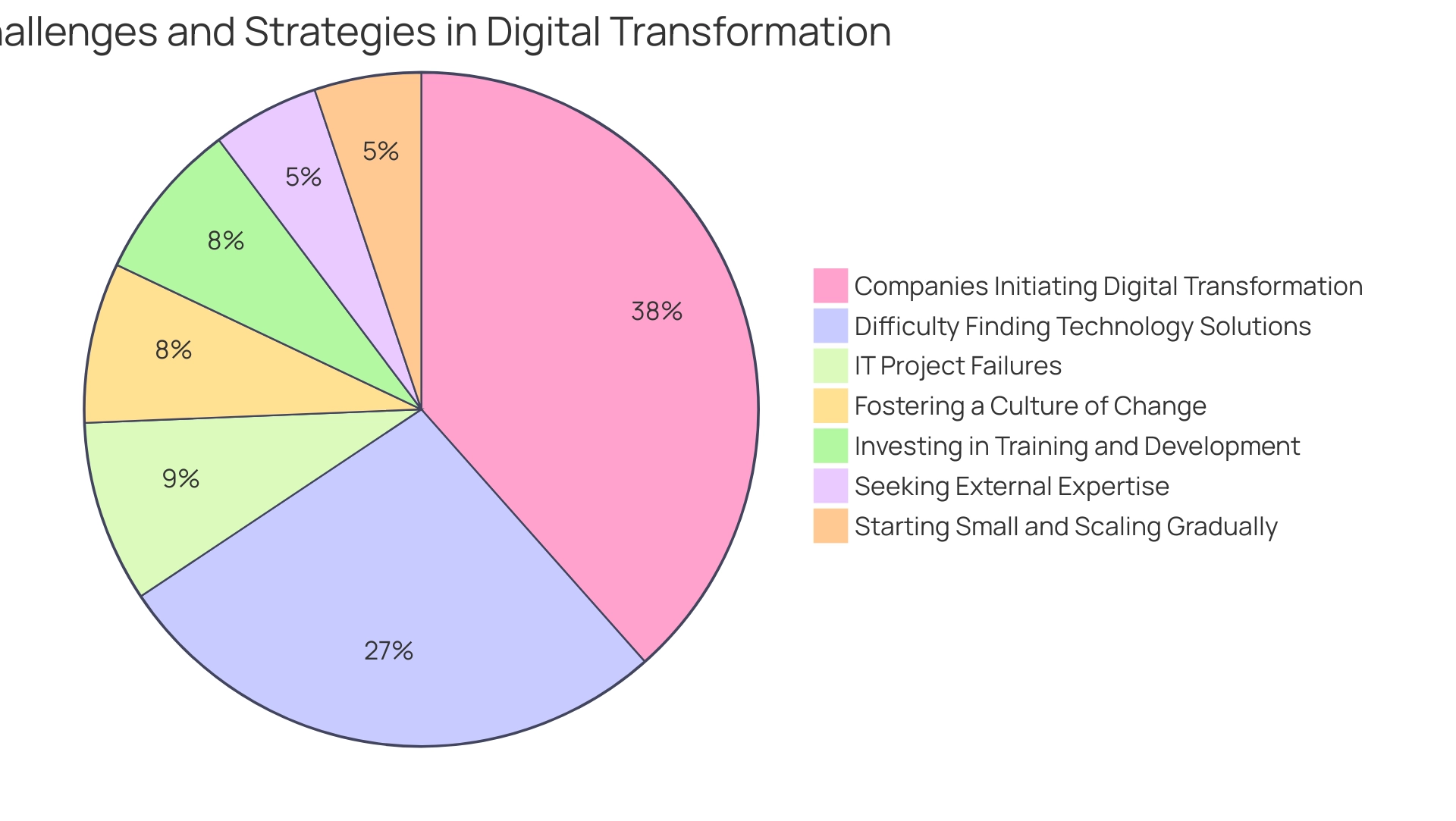
Conclusion
Digital transformation is not merely a trend; it is a fundamental shift that organizations must embrace to remain competitive in today's fast-paced digital landscape. The journey involves a comprehensive rethinking of processes, culture, and customer engagement, particularly within the e-commerce sector, where the benefits are evident in improved operational efficiency and enhanced customer satisfaction. By leveraging tailored digital solutions, businesses can significantly boost key performance indicators such as:
- Retention rates
- Average Order Value
- Lifetime Value
This drives growth and profitability.
However, the path to successful digital transformation is fraught with challenges. Resistance to change, integration of legacy systems, and the need for skilled personnel can hinder progress. It is imperative for organizations to align their digital initiatives with overarching business objectives, ensuring that every effort contributes meaningfully to strategic goals. Engaging leadership, conducting thorough assessments, and adopting a structured approach are essential best practices that can facilitate smoother transitions and foster a culture of innovation.
As the digital landscape continues to evolve, organizations must prioritize strategic planning and the selection of appropriate digital transformation services. By following best practices such as:
- Evaluating vendor expertise
- Prioritizing scalability
- Fostering a culture of change
Businesses can position themselves not only to overcome challenges but also to thrive in an increasingly competitive marketplace. Embracing digital transformation is no longer optional; it is a necessity for those aiming to secure their place in the future of commerce.





